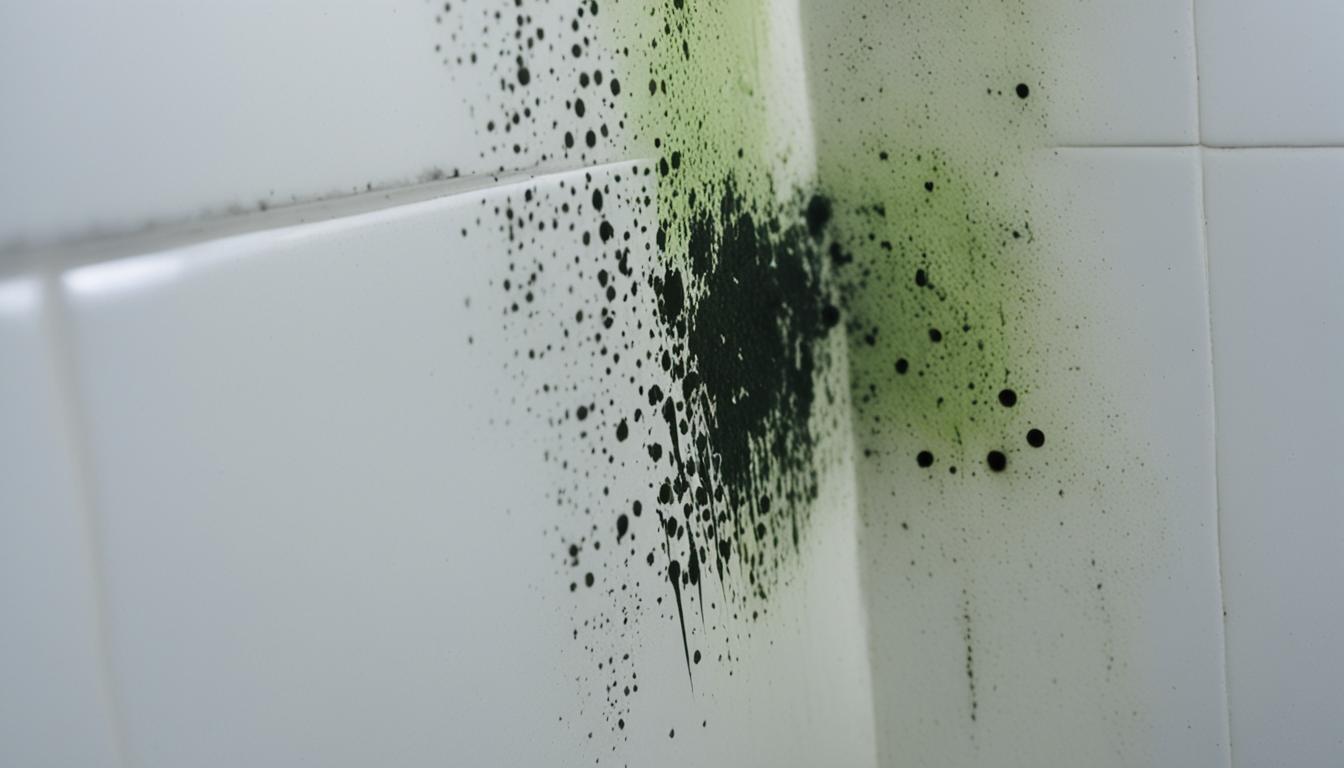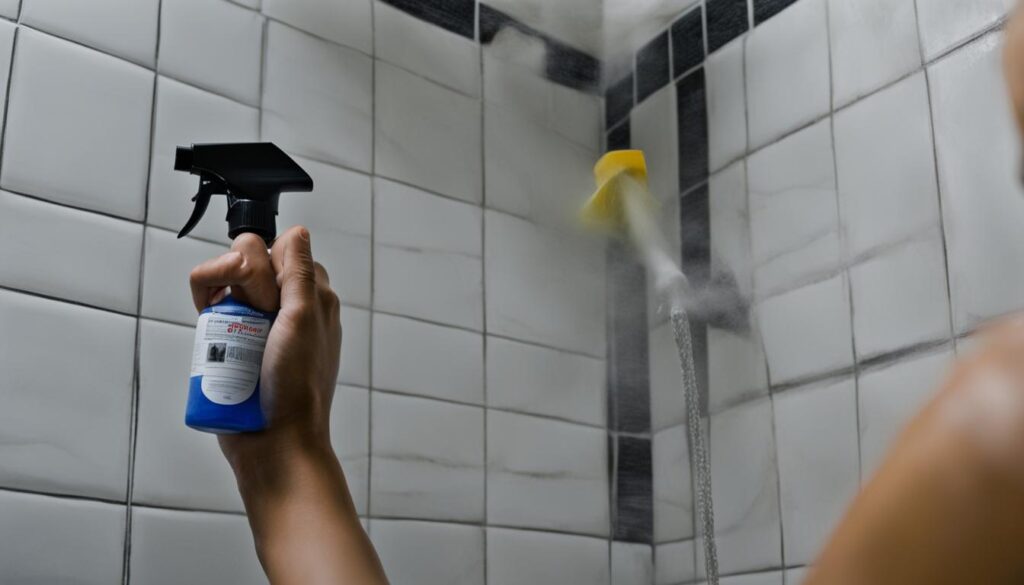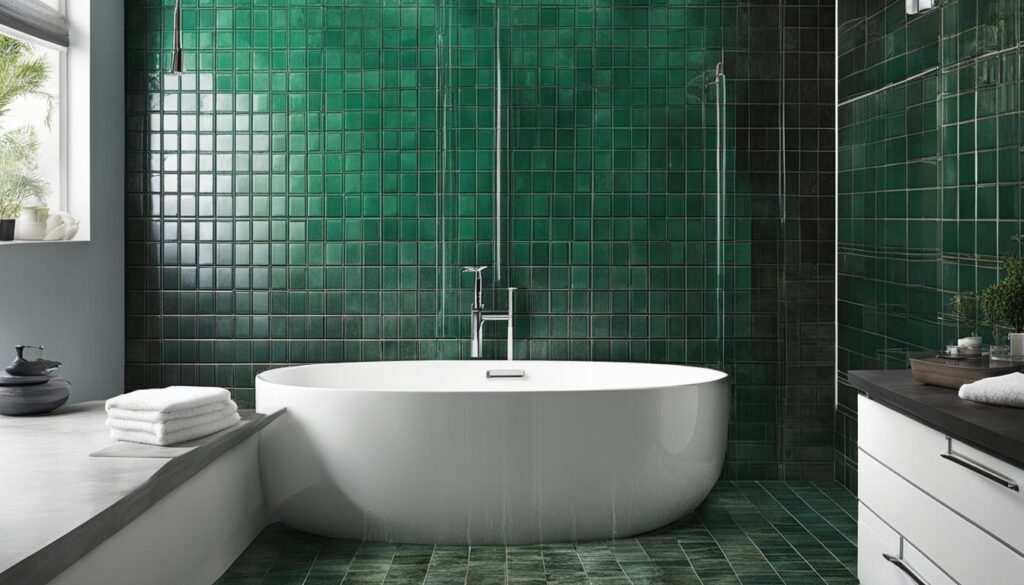
Eradicate Black Mold in Shower – Health Safety Tips
Welcome to our comprehensive guide on eradicating black mold in your shower. In this article, we will address the health risks associated with black mold in showers and provide expert tips on how to safely remove and prevent its growth. We will also explore various methods to maintain a mold-free bathroom environment, ensuring that you and your loved ones stay safe and healthy.
Black mold, commonly found in bathrooms, can pose significant health hazards if left unchecked. Exposure to black mold spores can lead to respiratory issues, allergies, and even more severe health complications. Therefore, it’s crucial to tackle the problem promptly and take preventive measures to avoid its reoccurrence.
Our step-by-step instructions will guide you in effectively removing black mold from your shower using recommended cleaning products and techniques. Additionally, we will share valuable insights on preventing black mold growth in your shower, such as proper ventilation and regular maintenance practices.
Throughout this article, we will also address the specific issue of mold growth in shower grout and provide solutions to keep your shower grout mold-free. By understanding the causes and implementing preventive measures, you can maintain a clean and hygienic shower environment.
Key Takeaways:
- Black mold in showers can pose health risks, including respiratory issues and allergies.
- Proper cleaning and maintenance are essential to remove and prevent black mold growth.
- Ensuring proper ventilation and reducing moisture levels can help prevent mold in your bathroom.
- Regularly cleaning and maintaining shower grout can prevent mold growth in those areas.
- By following our expert tips, you can create a mold-free and safe bathroom environment.
Understanding Black Mold in Showers
Black mold in showers can be a common problem that not only affects the aesthetics of your bathroom but also poses potential health hazards. Understanding the characteristics of black mold and how it commonly appears in showers is crucial for effective mold prevention and removal.
Characteristics of Black Mold
Black mold, scientifically known as Stachybotrys chartarum, is a type of fungus that thrives in damp and humid environments such as bathrooms. It appears as dark black or greenish patches on surfaces, often accompanied by a musty odor. The mold spores can spread through the air and cause respiratory issues, allergies, and other health problems when inhaled.
Common Causes of Black Mold in Showers
Mold growth in showers is primarily caused by moisture and lack of proper ventilation. The combination of frequent water exposure, inadequate drying, and poor airflow contributes to the ideal conditions for mold to flourish. Other factors such as leaks, plumbing issues, or damaged grout and caulk can also contribute to the growth of black mold.
The Importance of Regular Cleaning and Maintenance
To prevent black mold from taking hold in your shower, regular cleaning and maintenance are essential. It is recommended to clean your bathroom at least once a week, paying special attention to areas prone to moisture buildup such as shower walls, grout lines, and shower curtains. By keeping your bathroom clean and dry, you can significantly reduce the chances of black mold growth.
“Regular cleaning and maintenance are key to preventing black mold in showers. By taking proactive measures, you can ensure a mold-free and healthy bathroom environment.”
Here’s a helpful list of mold cleaning tips for your bathroom:
- Use a mixture of water and vinegar or a mild bleach solution to clean moldy areas.
- Scrub the surfaces with a brush or sponge to remove any visible mold.
- Pay attention to corners, grout lines, and areas with caulking as they are prone to mold growth.
- Ensure proper ventilation in your bathroom by using exhaust fans or opening windows to reduce moisture accumulation.
- Regularly check for leaks or plumbing issues and repair them promptly.
- Consider using mold-resistant paint or sealants on shower walls and surfaces to prevent mold growth.
By following these mold cleaning tips and practicing good bathroom maintenance habits, you can effectively combat black mold in your shower and create a healthy, mold-free environment for you and your family.
| Mold Cleaning Tips for Bathrooms |
|---|
| Use a mixture of water and vinegar or a mild bleach solution to clean moldy areas. |
| Scrub the surfaces with a brush or sponge to remove any visible mold. |
| Pay attention to corners, grout lines, and areas with caulking as they are prone to mold growth. |
| Ensure proper ventilation in your bathroom by using exhaust fans or opening windows to reduce moisture accumulation. |
| Regularly check for leaks or plumbing issues and repair them promptly. |
| Consider using mold-resistant paint or sealants on shower walls and surfaces to prevent mold growth. |
Removing Black Mold in Showers
Black mold in showers can not only be unsightly but also pose a risk to your health. It’s crucial to remove black mold promptly and effectively to maintain a clean and safe bathroom environment. In this section, we will provide step-by-step instructions on how to remove black mold from your shower, along with recommended cleaning products, techniques, and safety precautions.
Before you begin the removal process, ensure you have the following tools and materials:
- Gloves
- Protective eyewear
- Face mask
- All-purpose cleaner or a mixture of water and dish soap
- Vinegar
- Baking soda
- Scrub brush or sponge
- Old toothbrush
Tip: When using cleaning products, always follow the instructions on the label and work in a well-ventilated area.
Follow these steps to remove black mold from your shower:
- Put on your gloves, protective eyewear, and face mask before starting the cleaning process.
- Prepare a mixture of all-purpose cleaner or water and dish soap in a spray bottle.
- Thoroughly spray the affected areas with the cleaning solution.
- Allow the solution to sit on the black mold for a few minutes to loosen the mold growth.
- Using a scrub brush or sponge, scrub the moldy areas in a circular motion, applying moderate pressure.
- Rinse the area with water to remove the cleaning solution and loosened mold particles.
- If any stubborn mold stains persist, create a paste by mixing equal parts vinegar and baking soda.
- Apply the vinegar and baking soda paste to the stubborn stains and gently scrub with an old toothbrush.
- Rinse the area thoroughly with water to remove any residual paste and mold debris.
- Dry the shower surfaces completely to prevent mold from returning.
Remember to ventilate your bathroom by opening windows or using a dehumidifier to prevent moisture buildup, which can contribute to mold growth.
By following these step-by-step instructions and taking the necessary safety precautions, you can effectively remove black mold from your shower and ensure a clean and healthy bathroom for you and your family.

Preventing Black Mold in Showers
Preventing black mold from growing in your shower is crucial for maintaining a clean and healthy bathroom environment. By following expert tips on proper ventilation, regular maintenance practices, and effective habits, you can effectively prevent the growth of mold and mildew in your shower.
Proper Ventilation
One of the key factors in preventing black mold in showers is ensuring proper ventilation. Here are some steps you can take:
- Install an exhaust fan in your bathroom to remove excess moisture.
- Use a squeegee or towel to wipe down the shower walls and surfaces after each use.
- Keep the bathroom door or window open during and after showering to allow fresh air circulation.
Regular Maintenance Practices
Regular maintenance is essential for keeping your shower mold-free. Follow these practices:
- Clean your shower regularly using a mildew-resistant cleaner or a mixture of vinegar and water.
- Scrub the grout lines and seals to remove any buildup of soap scum or mold.
- Replace old or damaged caulk around the shower to prevent moisture from seeping in.
Effective Habits
In addition to proper ventilation and regular maintenance, adopting effective habits can significantly help in preventing black mold in showers:
- Keep shower curtains or doors open after use to allow air to circulate and dry out the shower area.
- Avoid leaving wet towels or clothes in the bathroom, as they can contribute to moisture buildup.
- Encourage family members to practice good hygiene by wiping down the shower after each use.
By incorporating these prevention methods into your routine, you can successfully maintain a mold-free shower and promote a healthy bathroom environment.
| Prevention Methods | Effectiveness | Difficulty Level |
|---|---|---|
| Proper ventilation | Highly effective in reducing moisture levels | Easy to implement with the installation of an exhaust fan |
| Regular maintenance practices | Effective in preventing mold growth when done consistently | Requires regular cleaning and upkeep |
| Effective habits | Can significantly contribute to maintaining a mold-free shower | Requires consistent adherence to new habits |
Shower Grout Mold – Causes and Solutions
Mold growth in shower grout is a common problem that many homeowners face. Not only does it look unsightly, but it can also pose potential health risks. Understanding the causes of shower grout mold is essential to effectively combat and prevent its growth. In this section, we will explore the underlying factors contributing to shower grout mold and provide practical solutions to keep your shower grout mold-free.
Causes of Shower Grout Mold
Shower grout provides the perfect breeding ground for mold due to its porous nature and constant exposure to moisture. Here are the primary causes of mold growth in shower grout:
- High humidity levels in the bathroom create an ideal environment for mold spores to thrive.
- Inconsistent or insufficient ventilation leads to moisture buildup, promoting mold growth.
- Failure to regularly clean and maintain the shower area allows mold to accumulate and spread.
Understanding these causes will help you implement targeted solutions to prevent shower grout mold.
Effective Cleaning Methods
To tackle existing shower grout mold, it is crucial to use effective cleaning methods. Here are a few tips to help you eliminate mold from your shower grout:
- Mix a solution of equal parts water and vinegar in a spray bottle. Spray the affected areas and let it sit for a few minutes before scrubbing with a brush or sponge.
- For tougher mold stains, create a paste using baking soda and water. Apply it to the grout lines and let it sit for about 15 minutes. Scrub the area using a brush or sponge, then rinse with water.
- Commercial mold and mildew cleaners can also be effective, but be sure to follow the manufacturer’s instructions and use protective gloves and proper ventilation.
Regularly cleaning your shower grout using these methods will help prevent mold from taking hold and spreading.
Preventive Measures for Mold-Free Shower Grout
Preventing mold in shower grout is key to maintaining a clean and healthy bathroom environment. Here are some preventive measures to consider:
- Ensure proper ventilation in your bathroom by using exhaust fans or opening windows to reduce humidity.
- Wipe down wet surfaces, such as walls, shower doors, and grout, after each use to prevent moisture buildup.
- Periodically inspect and repair any leaks in your shower, as even small leaks can contribute to mold growth.
- Apply a grout sealer to protect and seal the grout, making it less susceptible to moisture and mold.
By implementing these preventive measures, you can significantly reduce the likelihood of mold growth in your shower grout.

In the next section, we will conclude our discussion on black mold in showers and provide a summary of the key points covered in this article.
Conclusion
In conclusion, black mold in the shower is a common problem that can pose significant health risks if not addressed promptly. By following the expert tips and recommendations discussed in this article, you can effectively remove black mold from your bathroom and prevent its reoccurrence.
Regular cleaning and maintenance are essential to keep your shower mold-free. Taking preventive measures such as proper ventilation, thorough drying, and using mold-resistant products can go a long way in preventing black mold growth.
Remember to always prioritize your health and safety when dealing with black mold. Wear protective gear, such as gloves and masks, while cleaning, and ensure proper ventilation to minimize exposure to mold spores. Don’t hesitate to seek professional help if the mold growth is extensive or if you have any health concerns.
By eradicating black mold in showers and maintaining a mold-free bathroom environment, you can create a clean and healthy space for you and your family. So take action today to eliminate black mold and enjoy a fresh and inviting bathroom.




